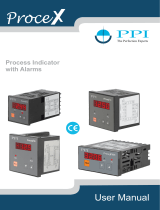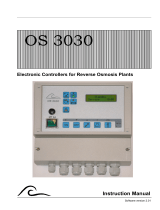CONTENTS
1.
THE MODELS......................................................................................................................................................................... 3
1.1
The accessories...................................................................................................................................................................... 3
2.
DESCRIPTION OF THE MAIN COMPONENTS AND FUNCTIONS ................................................................................ 4
2.1
Level control.......................................................................................................................................................................... 5
2.1.1
Working level switch......................................................................................................................................................... 5
2.1.2
Safety level switch............................................................................................................................................................. 5
2.2
Overfill device....................................................................................................................................................................... 5
2.3
Regulation of steam production.............................................................................................................................................. 5
2.4
Measurement of the conductivity of the supply water - alarm thresholds................................................................................. 5
2.5
Automatic draining................................................................................................................................................................ 5
2.6
Foam elimination procedure................................................................................................................................................... 5
2.7
Safety thermostat ................................................................................................................................................................... 5
2.8
Autotest procedure................................................................................................................................................................. 6
2.9
Measurement of the water temperature and pre-heating (not available in the version with type C control module)..................6
2.10
Dehumidification request signal (not available in the version with type C control module) ..................................................... 6
2.11
Deposit detector for the heating elements (optional in the version with type C control module, std. in the versions with type H
or T control module) ........................................................................................................................................................................... 6
3.
REGULATION PRINCIPLES ................................................................................................................................................ 7
3.1
ON/OFF regulation (control module C).................................................................................................................................. 7
3.2
Modulating regulation (control module H).............................................................................................................................. 7
3.2.1
ON/OFF regulation (parameter A0=0)................................................................................................................................ 7
3.2.2
Autonomous regulation with relative humidity transducer (parameter A0=2)...................................................................... 7
3.2.3
Autonomous regulation with ambient relative humidity transducer and supply humidity limiting transducer (param. A0=3)8
3.2.4
Application for steam baths (type T control module) .......................................................................................................... 8
3.3
Setting the alarm thresholds (type H or T control module)...................................................................................................... 8
4.
MOUNTING THE UNIT......................................................................................................................................................... 9
4.1
Receipt and storage................................................................................................................................................................ 9
4.2
Dimensions and weights ........................................................................................................................................................ 9
4.3
Removing and replacing the front casing................................................................................................................................ 9
5.
POSITIONING THE UNIT................................................................................................................................................... 10
5.1
Fastening............................................................................................................................................................................. 10
6.
HYDRAULIC CONNECTIONS............................................................................................................................................ 11
6.1
Supply water characteristics................................................................................................................................................. 11
6.2
Characteristics of the drain water......................................................................................................................................... 11
6.3
Technical specifications....................................................................................................................................................... 11
6.3.1
Table of technical specifications....................................................................................................................................... 12
6.3.2
Diagram of hydraulic connections .................................................................................................................................... 12
6.4
Checks................................................................................................................................................................................. 12
7.
ELECTRICAL CONNECTIONS .......................................................................................................................................... 13
7.1
Power supply voltages.......................................................................................................................................................... 13
7.2
Checking the voltage of the auxiliary circuit transformer...................................................................................................... 14
7.3
Main control board............................................................................................................................................................... 14
7.4
Description of the terminal block and connections
(functions and electrical specifications)............................................................ 14
7.5
Auxiliary connections........................................................................................................................................................... 15
7.5.1
Type C control module with ON/OFF action .................................................................................................................... 15
7.5.2
Type H control module with modulating action................................................................................................................ 15
7.5.3
Control module T for steam baths with modulating action................................................................................................ 16
7.6
Other auxiliary contacts ....................................................................................................................................................... 16
7.6.1
Alarm contact .................................................................................................................................................................. 16
7.6.2
Dehumidification contact ................................................................................................................................................. 16
7.6.3
Remote terminal / supervisory system.............................................................................................................................. 16
7.6.4
Using different brand probes............................................................................................................................................ 17
7.7
Checks................................................................................................................................................................................. 17
7.8
Wiring diagrams for the connection of the elements at the headers ....................................................................................... 18
7.9
Single-phase wiring diagram for 2-4kg/h humidifiers with type C control module................................................................. 19
7.10
Single-phase wiring diagram for 2-4kg/h humidifiers with type H or T control module......................................................... 20
7.11
Single-phase wiring diagram for 6kg/h humidifiers with type C control module.................................................................... 21
7.12
Single-phase wiring diagram for 6kg/h humidifiers with type H or T control module............................................................ 22
7.13
Three-phase wiring diagram for humidifiers with type C control module.............................................................................. 23
7.14
Three-phase wiring diagram for humidifiers with type H or T control module....................................................................... 24
8.
Steam distribution.................................................................................................................................................................. 25
8.1
Ambient steam distribution: ventilated steam distributors..................................................................................................... 25
8.2
Steam distribution in cold rooms.......................................................................................................................................... 25
8.3
Ducted steam distribution: linear and concentrated jet distributors (OEM)................................................................................... 25
8.4
Concentrated jet steam distribution (OEM).......................................................................................................................... 26
8.5
Positioning linear distributors in the air duct........................................................................................................................ 26





















